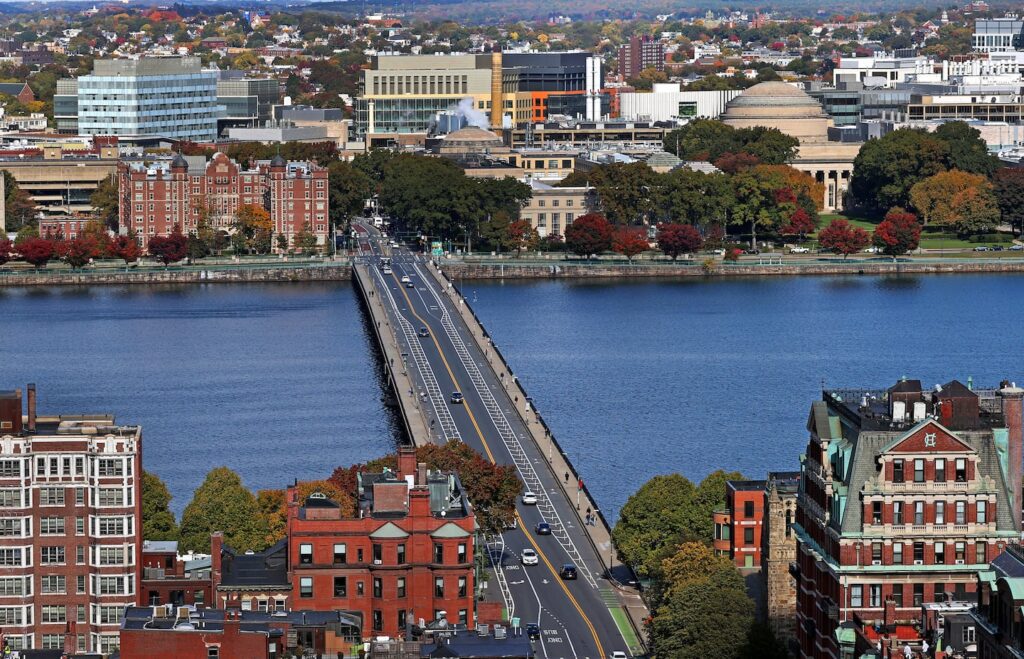“When a student is thinking about making an investment in their education, and they’re looking at which English-speaking country they may be going to, it’s going to be harder for the United States to stay competitive,” said Sarah Spreitzer, vice president of government relations at the American Council on Education.
In New England, any decrease in enrollment could be a significant hit. Nearly a dozen schools in the region count more than 1,000 international students each, and at some universities, international students are a significant presence on campus. At Northeastern University, international students made up 38 percent of the school population in Fall 2024, according to its website. At Boston University in Fall 2023, it was 29 percent.
Other institutions have international cohorts numbering in the low hundreds — but for small colleges, that’s often still enough to make up a sizable percentage of the student body.
Overall in 2023-24, international students contributed $43.8 billion to the US economy, in tuition and fees as well as living expenses, according to the NAFSA Association of International Educators.
Given Boston’s reputation as a bastion of higher education, it’s no surprise that a big slice of the economic impact — $3.9 billion, according to NAFSA — is centered in Massachusetts. The Bay State hosts the fourth-highest total of international students, behind California, New York, and Texas, supporting thousands of jobs in retail, dining, and other sectors.
“They’re renting apartments, they’re buying cars, they’re purchasing goods and services in the communities where their institution of higher education is located,” said Spreitzer. “So it’s a huge economic advantage for the United States to welcome these international students.”
But recent moves by the Trump administration have put current and prospective international students on edge.
Earlier this month, immigration officials arrested Mahmoud Khalil, a former graduate student and legal permanent resident, over his role in student demonstrations at Columbia University last year. Another Columbia student fled her on-campus apartment for Canada after abruptly learning her visa had been revoked. And a doctor at Brown University’s medical school was deported after arriving at Logan International Airport, despite a court ordering her held in Massachusetts.
Last week, Brown warned international students, including permanent residents, to postpone travel plans outside the country, citing potential changes to the re-entry process. Other institutions, such as Dartmouth College and Northeastern, have issued advisories about a new travel ban, which is thought to be imminent.
That means the U.S. may lose interested students to other countries such as Canada and Australia, which have seen their international enrollments surge in recent years. Spreitzer said those countries offer something that the United States, at the moment, does not: the certainty that “once you’re in,” immigration authorities won’t suddenly ”change the terms” of entrance to the country, in law or in practice.
That’s especially an issue considering that international students often pay “full freight” tuition and fees — effectively helping pay for domestic students on scholarships and financial aid.
For small colleges that may be having difficulties attracting domestic enrollment, Spreitzer added, those international students can act as a lifeline.
Here are some the colleges and universities in New England with the largest populations of international students, according to online data published by the schools.
Harvard University, Cambridge
International students overall (undergraduate and graduate): 6,631 (27 percent of total student population) as of Fall 2023
International graduate/professional students: 5,645 (32 percent)
Massachusetts Institute of Technology, Cambridge
International students overall (undergraduate and graduate): 3,455 (29 percent) as of Fall 2024
International graduate/professional students: 2,926 (40 percent)
Northeastern University, Boston
International students overall: 18,508 (38 percent) as of Fall 2024
International graduate/professional students: 15,285 (64 percent)
Boston University, Boston
International students overall: 10,740 (29 percent) as of Fall 2023
International graduate/professional students: 6,441 (36 percent)
Tufts University, Medford/Somerville
International students overall: 1,912 (14 percent) as of Fall 2024
International graduate/professional students: 971 (15 percent)
Babson College, Wellesley
International students overall: 1,358 (34 percent) as of Fall 2024
International graduate/professional students: 516 (45 percent)
Berklee College of Music, Boston
International students overall: 2,101 (39 percent)
Boston College, Chestnut Hill
International students overall: 1,873 (12 percent) as of Fall 2023
International graduate/professional students: 938 (18 percent)
Brandeis University, Waltham
International students overall: 1,280 (25 percent) as of Fall 2024
International graduate/professional students: 580 (37 percent)
Brown University, Providence, R.I.
International students overall: 2,470 (21 percent)
International graduate, non-medical students: 1,397 (41 percent)
Dartmouth College, Hanover, N.H.
International students overall: 1,470 (21 percent) as of Fall 2024
International graduate/professional students: 762 (32 percent)
International students overall: 896 (16 percent) as of Fall 2023
Hult International Business School, Cambridge
International students overall: 945 (87 percent) as of Fall 2024
International graduate students: 531 (94 percent)
Rhode Island School of Art & Design, Providence, R.I.
International students overall: 924 (37 percent)
College of the Atlantic, Bar Harbor, Maine
International undergraduate students: 77 (21 percent) as of Fall 2023
Mount Holyoke College, South Hadley
International undergraduate students: 428 (20 percent) as of Fall 2024
Suffolk University, Boston
International students overall: 948 (14 percent) as of Fall 2023
International graduate, non-law students: 398 (18 percent)
Wellesley College, Wellesley
International students overall: 316 (13 percent) as of Fall 2024
Yale University, New Haven, Conn.
International students overall: 3,564 (24 percent) as of Fall 2023
International graduate/professional students: 2,840 (34 percent)
University of Massachusetts Amherst
International students overall: 4,542 (14 percent)
International graduate/professional students: 2,683 (34 percent) as of Fall 2024
Correction: Due to incorrect information on the school’s website and a reporting error, a previous version of this story gave an incorrect number and percentage of international graduate students at University at Massachusetts Amherst. As of Fall 2024, 34 percent of graduate students at UMass Amherst were international students.
Camilo Fonseca can be reached at camilo.fonseca@globe.com. Follow him on X @fonseca_esq and on Instagram @camilo_fonseca.reports.

